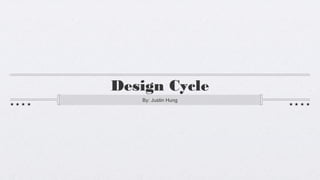
Design Cycle
- 1. Design Cycle By: Justin Hung
- 2. Definition Has 5 Steps Helps you work easier Uses step by step procedure Make your product better
- 3. Investigate The first step is investigate. In investigate you will learn and know your problem. Investigation is an essential stage in the Design Cycle. Students are expected to identify the problem, develop a design brief, and formulate a design specification. Students are expected to acknowledge the sources of information and document them appropriately. In other words, the students should create a Bibliography of all sources of information used in their work.
- 4. Design The second step is design. In design you would find out all the solutions and surely there are a lot of solutions but in this stage you will also choose the best solution for your problem. Students design the product/solution. When finished students should be able to: •Generate several feasible designs that meet the Design Specification •Evaluate the designs against the Design Specification •Select one design and justify its choice
- 5. Plan The next step is to plan. You would plan on how would you do it. Where, when, how, why and who will you use. You would think of everything you are going to do and imagine the problems that might happen. Everything that might happen will happen so you have to make a back up plan in case your original plan fails or you have to make sure that the problems do not happen.
- 6. Create The next step is create. In create you will follow the plan and do what you have to do to finish what you have to do. Students are expected to: •To document the process of making their product/solution. This documentation can be in the form of a series of photos, a video and dated record, a PowerPoint presentation, or any other way which creates a record of what was done. Included in this documentation should be a record of how and when they use tools, materials, and techniques. •To follow their plan, to evaluate it, and justify any changes (when necessary) they make to the plan while they are creating the product/solution. •To ensure a safe working environment for themselves and others as they create their product/solution. •To create a product/solution of appropriate quality.
- 7. Evaluate And the last step is to evaluate. In evaluate you see how well you did and you evaluate your self if the product was a good product or a bad one. Students are expected to: •Carry out tests to evaluate the product/solution against the original Design Specification •Evaluate the success of the product/solution in an objective manner based on the testing, their own views, and the views of the intended user (peers) •Evaluate the impact of the product/solution on individuals and on society •Discuss possible improvements for the product/solution
- 8. Thank You For Reading
